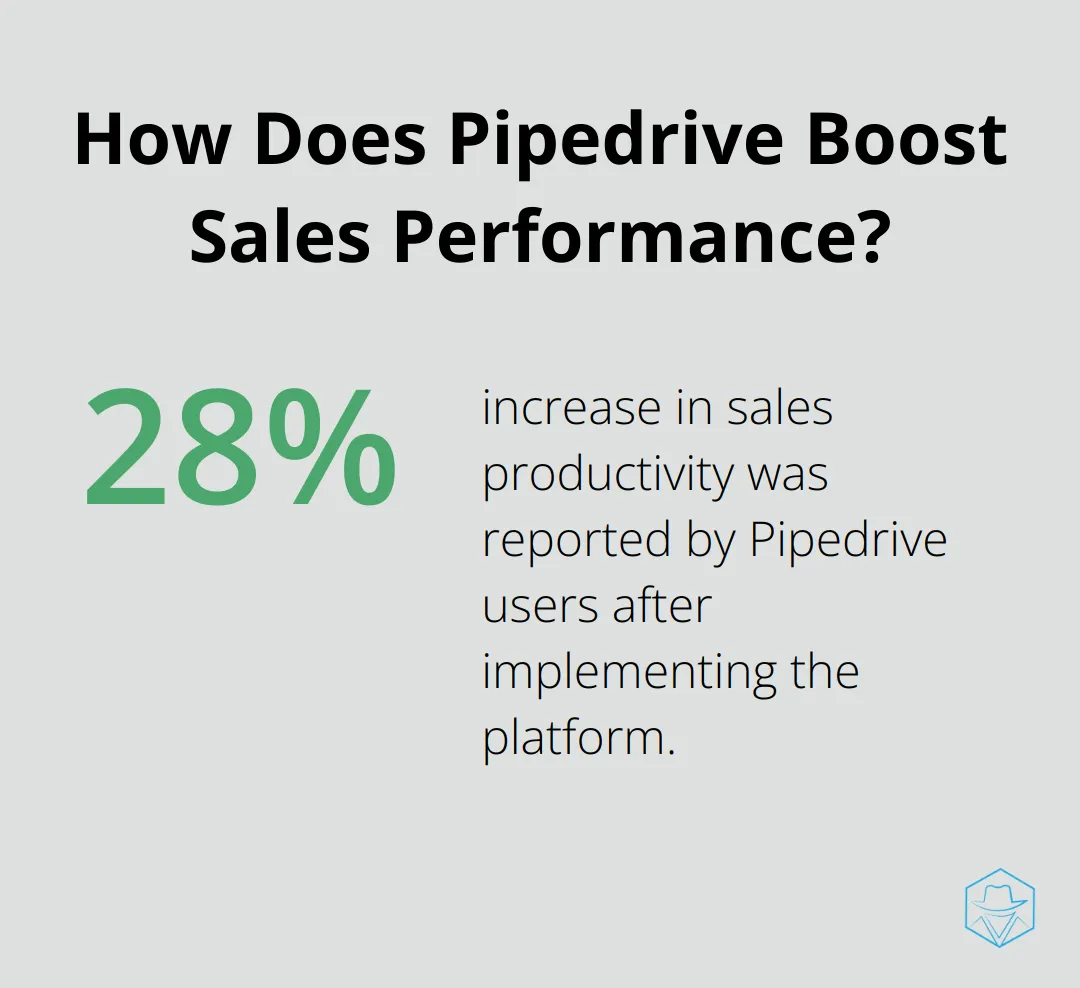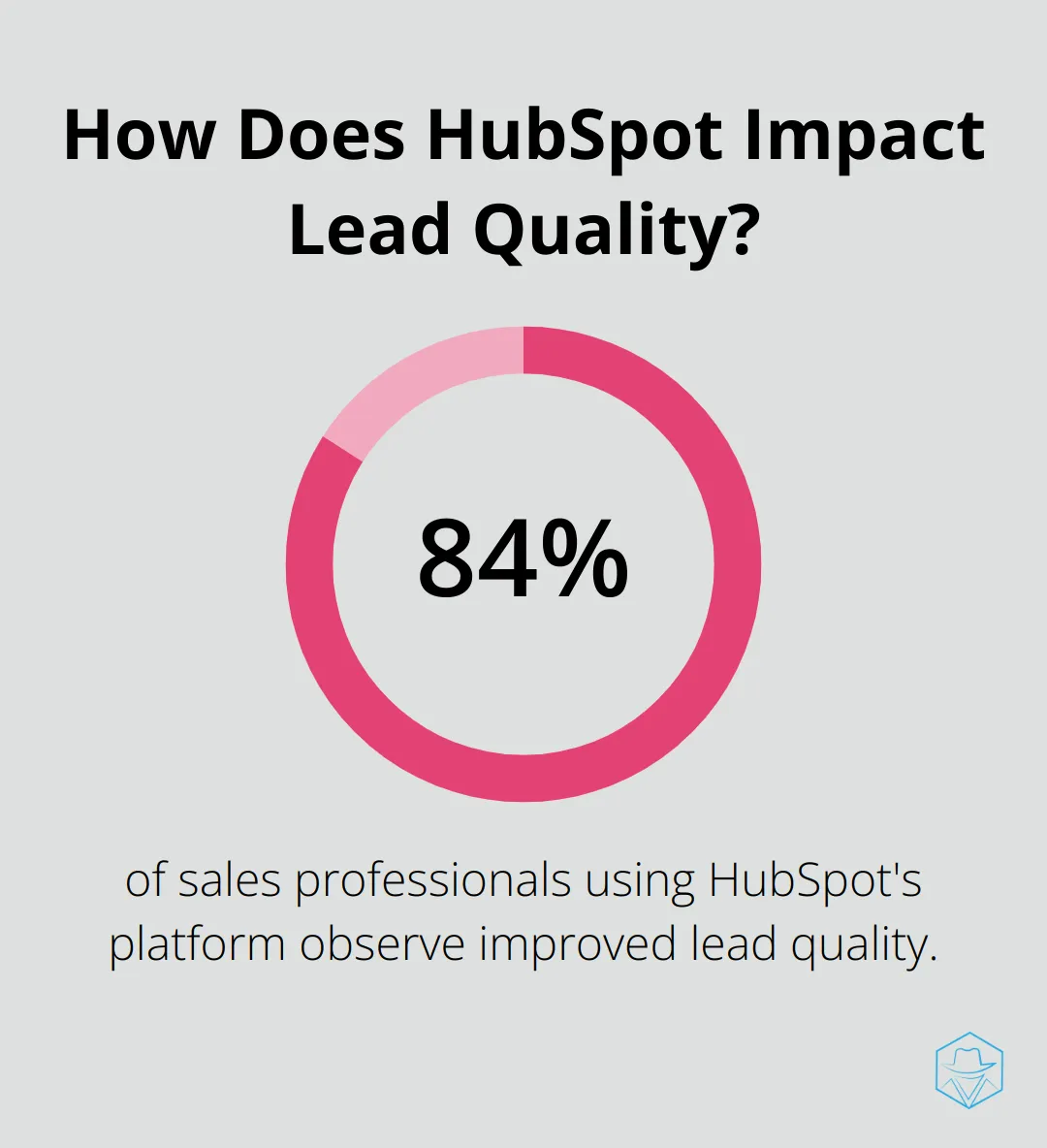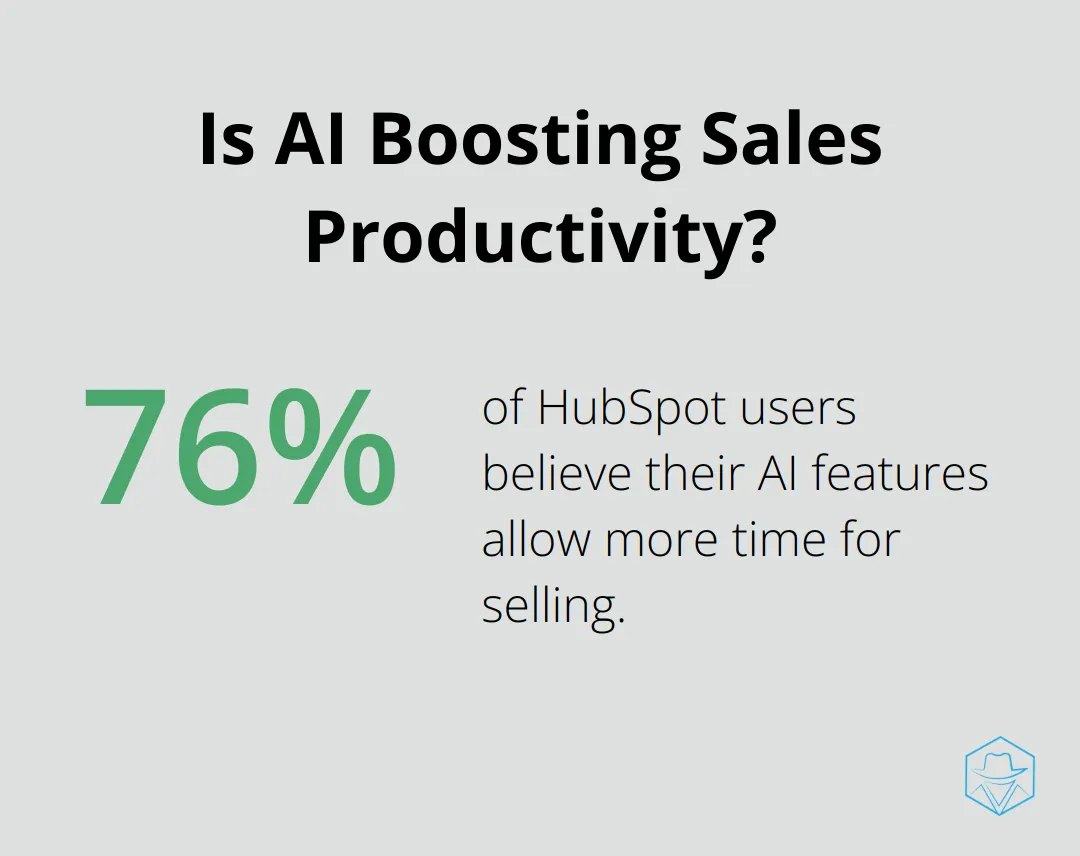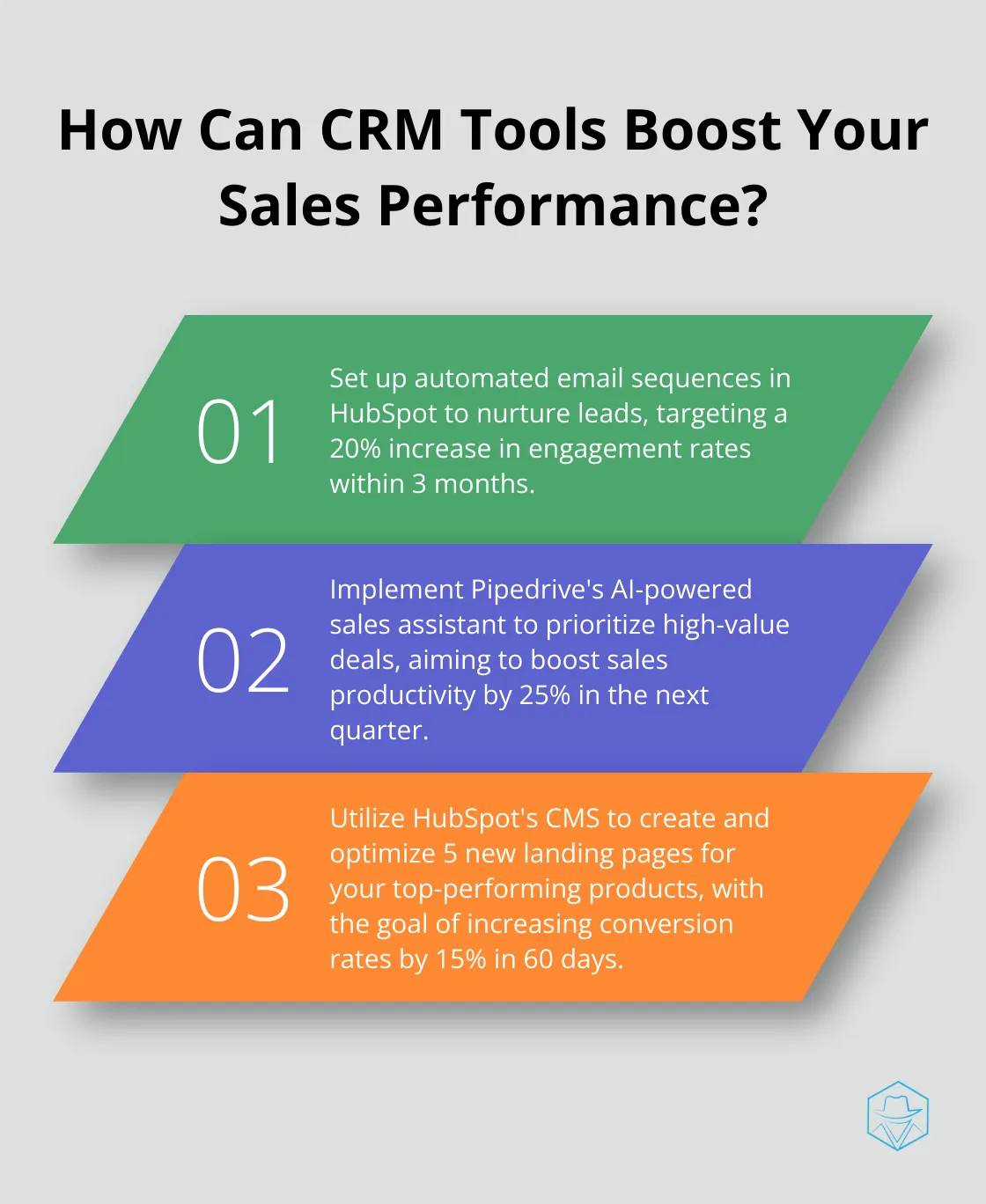Pipedrive vs HubSpot: Which CRM is Right for You?

Choosing the right CRM can make or break your sales and marketing efforts. At Drop Cowboy, we understand the importance of this decision for businesses of all sizes.
In this post, we’ll compare two popular CRM platforms: Pipedrive vs HubSpot. We’ll examine their features, pricing, and ideal use cases to help you make an informed choice for your business.
What is Pipedrive CRM?
Pipedrive is a sales-focused CRM that emphasizes simplicity and efficiency in sales pipeline management. Its core offering includes a visual, drag-and-drop interface that enables sales teams to track and manage deals through customizable stages.
Key Features of Pipedrive
Pipedrive’s standout feature is its AI-powered sales assistant. This tool provides data-driven insights and recommendations to help sales reps prioritize their efforts and close deals faster. (According to Pipedrive’s internal data, users have reported up to a 28% increase in sales productivity after implementing the platform.)

The platform also excels in email integration, allowing users to sync their email accounts and track all communications within the CRM. This feature proves particularly useful for small to medium-sized businesses that rely heavily on email for client interactions.
Pricing and Accessibility
Pipedrive offers a straightforward, user-based pricing structure. The Essential plan starts at $14.90 per user per month, making it an attractive option for smaller teams or businesses just starting with CRM implementation. The company provides a 14-day free trial, allowing potential users to test the platform before committing.
Ideal Use Cases
Pipedrive suits businesses with a strong focus on sales pipeline management. Its visual interface and customizable stages make it ideal for companies that need to track complex sales processes or have long sales cycles.
Small to medium-sized businesses in B2B sectors often find Pipedrive’s features align well with their needs. For instance, a software company selling to other businesses might benefit from Pipedrive’s ability to track multiple touchpoints and stages in the sales process.
Limitations and Alternatives
While Pipedrive excels in sales management, it may not fit businesses seeking a comprehensive marketing automation solution. In such cases, platforms like HubSpot or Drop Cowboy might be more suitable, especially for businesses looking to integrate advanced marketing features with their CRM.
As we move forward to explore HubSpot, we’ll see how its broader feature set compares to Pipedrive’s sales-focused approach.
What Does HubSpot Offer?
HubSpot provides a comprehensive CRM platform that extends beyond sales management. It offers a suite of tools for marketing, customer service, and content management. This all-in-one approach distinguishes it from sales-focused CRMs like Pipedrive.
Robust Marketing Automation
HubSpot’s marketing hub stands out as a key feature. It includes tools for email marketing, social media management, and lead nurturing. (HubSpot’s data indicates that businesses using their marketing tools experience an average increase of 129% in leads within the first year.)

The platform’s content management system (CMS) enables users to create and optimize website content, landing pages, and blogs. This integration between marketing and CRM functions allows businesses to track the entire customer journey from initial contact to closed deal.
Sales and Service Hubs
While HubSpot’s marketing tools impress, its sales and service hubs pack equal power. The sales hub features email tracking, meeting scheduling, and pipeline management. (HubSpot reports that 84% of sales professionals using their platform observe improved lead quality.)
The service hub offers tools for customer support, including a ticketing system, knowledge base, and customer feedback surveys. This integration of sales and service data provides a comprehensive view of customer interactions.
Pricing and Scalability
HubSpot’s pricing structure presents more complexity than Pipedrive’s. They offer a free tier with basic CRM features, which serves as a good starting point for small businesses. Paid plans begin at $50 per month for the Starter suite, which includes marketing, sales, and service hubs.
As businesses expand, they can upgrade to more advanced plans, with the Enterprise suite costing $5,000 per month. This scalability makes HubSpot suitable for businesses of various sizes, from startups to large enterprises.
Ideal Use Cases
HubSpot suits businesses seeking an all-in-one solution to manage their entire customer lifecycle. It benefits companies with strong inbound marketing strategies or those looking to implement one.
For example, a growing e-commerce business might find HubSpot’s combination of marketing automation, sales tracking, and customer service tools invaluable for managing customer relationships across multiple touchpoints.
However, businesses primarily focused on sales pipeline management or those with limited marketing needs might find HubSpot’s extensive feature set excessive. In such cases, a more focused solution like Pipedrive or Drop Cowboy might prove more appropriate and cost-effective.
Now that we’ve explored HubSpot’s offerings, let’s compare it directly with Pipedrive to help you determine which CRM aligns best with your business needs.
Pipedrive vs HubSpot Head-to-Head
User Experience and Learning Curve
Pipedrive offers an intuitive, visual interface. Its drag-and-drop pipeline view enables sales teams to manage deals without extensive training. This simplicity benefits small businesses or those new to CRM systems.

HubSpot, while powerful, requires more time to master due to its comprehensive feature set. However, HubSpot Academy provides extensive free training resources, which can reduce onboarding time. (Users report an average activation time of just 36 days for their Sales Hub.)
Sales Pipeline Management
Both platforms excel in pipeline management, but with different approaches. Pipedrive’s core strength lies in its visual pipeline, which allows sales reps to move deals through stages effortlessly. (This visual approach has helped Pipedrive users increase sales productivity by up to 28%.)
HubSpot’s pipeline management relies more on data, with AI-powered tools for deal scoring and forecasting. HubSpot states that 76% of users believe their AI features allow more time for selling, which boosts productivity significantly.
Marketing Capabilities
This area highlights significant differences between the platforms. Pipedrive focuses primarily on sales, with limited marketing features. It suits businesses that handle marketing separately or have minimal marketing needs.
HubSpot offers a full-fledged marketing suite. Its Marketing Hub includes tools for email marketing, social media management, and content creation. HubSpot users acquire 129% more leads on average within the first year of using the platform.
For businesses that need comprehensive marketing automation alongside CRM functionality, HubSpot stands out. However, if you focus purely on sales management, Pipedrive’s streamlined approach might work better.
Integration Ecosystem
Both platforms provide extensive integration options, but HubSpot leads with over 1,000 third-party app integrations compared to Pipedrive’s 400. This difference matters for businesses with complex tech stacks or specific tool requirements.
Pipedrive may have fewer direct integrations, but it offers robust API access, which allows for custom integrations if you have the technical resources.
Scalability and Customization
Pipedrive’s simplicity makes it ideal for small to medium-sized businesses, but it may not meet the complex needs of large enterprises. Its customization options, while present, don’t match HubSpot’s capabilities.
HubSpot’s scalability gives it a significant advantage. Its tiered pricing structure and extensive feature set allow businesses to start small and expand their usage as they grow. The platform’s custom objects feature enables advanced customization to fit unique business processes.
When you consider scalability, think about your long-term business goals. If rapid growth features in your plans, HubSpot’s scalability might provide a more future-proof solution.
Final Thoughts
Pipedrive vs HubSpot presents a choice between simplicity and comprehensiveness. Pipedrive excels in sales-focused approaches, ideal for small to medium businesses prioritizing streamlined sales processes. HubSpot offers a robust all-in-one platform, suitable for companies seeking integrated marketing, sales, and service solutions.

Your decision should align with your long-term business objectives and growth trajectory. Consider factors such as scalability, marketing needs, and budget constraints when selecting between these CRMs. (HubSpot users report a 129% increase in leads within the first year, showcasing its potential for growth-oriented businesses.)
While both platforms offer valuable features, some businesses might benefit from specialized solutions. Companies looking to enhance their marketing efforts through innovative communication channels should explore Drop Cowboy, which provides ringless voicemail and SMS marketing capabilities alongside CRM integration. Take advantage of free trials to test these platforms before making your final decision.
blog-dropcowboy-com
Related posts

April 14, 2025
How to Create Effective Email Templates for Shopify
Create effective email templates for Shopify to boost engagement and sales. Learn key strategies and practical tips to improve your Shopify email campaigns.

March 19, 2025
How to Choose the Best CRM for Marketing Automation
Find the right CRM for marketing automation and boost your business efficiency with these practical tips and tools. Learn how to make an informed choice.

March 21, 2025
Key Benefits of Marketing Automation Revealed
Explore key benefits of marketing automation for efficiency, increased ROI, and enhanced customer engagement. Transform your strategy with proven insights.

March 13, 2025
How to Master Marketing Automation Best Practices
Optimize your strategy with marketing automation best practices. Boost efficiency, engage customers, and increase conversion rates effectively.

March 9, 2025
Top Ringless Voicemail Drop Software Solutions
Explore top ringless voicemail drop software for efficient customer outreach and boost engagement in your communication strategy.

April 17, 2025
Crafting a Winning Marketing Automation Strategy
Boost sales and efficiency! Learn how to craft a marketing automation strategy to streamline processes and enhance customer engagement effectively.